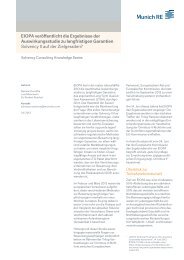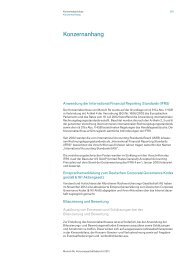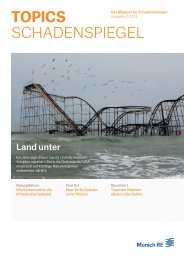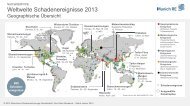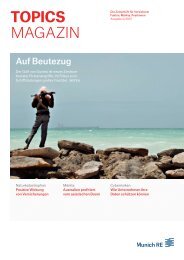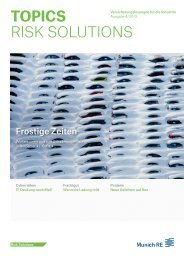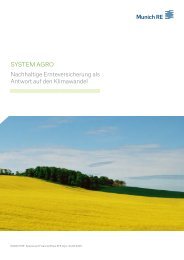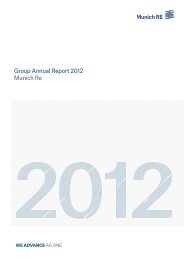Munich Re Group Annual Report 2006 (PDF, 1.8
Munich Re Group Annual Report 2006 (PDF, 1.8
Munich Re Group Annual Report 2006 (PDF, 1.8
Create successful ePaper yourself
Turn your PDF publications into a flip-book with our unique Google optimized e-Paper software.
<strong>Munich</strong> <strong>Re</strong> <strong>Group</strong> <strong>Annual</strong> <strong>Re</strong>port <strong>2006</strong> General information_Glossary<br />
F – L<br />
Facultative reinsurance<br />
The reinsurer assumes a share of selected individual risks. The primary<br />
insurer can offer an individual risk in reinsurance, which the<br />
reinsurer for its part can either accept or decline (cf. obligatory<br />
reinsurance).<br />
Fair value<br />
The amount for which an asset could be exchanged between knowledgeable,<br />
willing parties in an arm’s-length transaction. Where there<br />
is an active market, the fair value of an asset is its current market<br />
value. Alternatively, the fair value may be determined on the basis of<br />
recognised valuation methods.<br />
Fast close<br />
The sum of organisational and technical improvements in business<br />
processes that serve to accelerate publication of a company’s quarterly<br />
and annual financial statements within the legal deadlines.<br />
Financial Accounting Standards (FASs)<br />
US accounting regulations that give detailed rulings on individual<br />
accounting questions and which must be complied with by listed<br />
companies that prepare accounts in accordance with US GAAP.<br />
Financial institutions<br />
Banks and other financial services providers.<br />
Forward<br />
Contract to trade at a specified price on a specified future date. In<br />
contrast to futures, forwards tend to be individually designed <br />
derivative financial instruments.<br />
Future<br />
Standardised contract to trade a financial instrument on a money<br />
market, capital market, precious-metals market or currency market at<br />
a specific price and on a specific future date. Frequently, rather than<br />
actually delivering the underlying financial instrument on that date,<br />
the difference between closing market value and the exercise price is<br />
settled in cash.<br />
Goodwill<br />
Any excess of the purchase price of a subsidiary over the acquirer’s<br />
interest in the fair value of the net assets as at the acquisition date.<br />
Goodwill is not amortised but subjected to an impairment test. A<br />
writedown is made for any impairment loss.<br />
Gross/net<br />
The terms gross and net mean before and after deduction of the portion<br />
attributable to business ceded in reinsurance. Instead of “net”,<br />
the term “for own account” is sometimes used.<br />
222<br />
Hedging<br />
Protecting against undesirable developments in prices by means of<br />
special financial contracts, especially derivative financial instruments.<br />
Depending on the risk to be hedged, a distinction is made<br />
between two basic types: “fair value hedges” safeguard assets or<br />
liabilities against the risk of changes in value; “cash flow hedges”<br />
reduce the risk of fluctuations in future cash flows.<br />
IBNR reserve<br />
Provision for claims that are not yet known to the insurer (IBNYR =<br />
incurred but not yet reported) but also for claims whose case<br />
reserves are not sufficient (IBNER = incurred but not enough<br />
reserved).<br />
Integrated risk management (IRM)<br />
Holistic management of insurance risks in life and non-life business<br />
and of investment risks. IRM essentially rests on four pillars: assetliability<br />
management, active capital management, accumulation<br />
control, and operational risks.<br />
International Accounting Standards Board (IASB)<br />
An international body of 14 accounting experts responsible for issuing<br />
IASs/IFRSs. The IASB’s objective is to achieve uniformity in the<br />
accounting principles that are used by businesses and other organisations<br />
for financial reporting around the world.<br />
International Accounting Standards (IASs)/ International Financial<br />
<strong>Re</strong>porting Standards (IFRSs)<br />
Standards formulated by the IASB with the intention of achieving<br />
internationally comparable preparation and presentation of financial<br />
statements. Since 2002 the standards adopted by the IASB have<br />
been referred to as International Financial <strong>Re</strong>porting Standards<br />
(IFRSs). Until existing standards are renamed, they continue to be<br />
referred to as International Accounting Standards (IASs).<br />
Investments for the benefit of life insurance policyholders who bear<br />
the investment risk<br />
Investments for policyholders under unit-linked life insurances.<br />
They also include investments under index-linked life insurance<br />
policies whose performance depends on share or currency indices.<br />
Obligations arising from this type of contract are mainly recognised<br />
under the balance sheet item “technical provisions for life insurance<br />
policies where the investment risk is borne by the policyholders”.<br />
Layer<br />
Term used in excess-of-loss reinsurance to denote a stratum of<br />
cover. Its point of attachment and extent is defined in terms of the<br />
sum insured. Example: €5,000 in excess of €1,000 refers to the layer<br />
€1,000 to €6,000.



